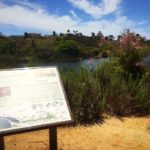I have a confession to make: I am absolutely, positively obsessed with Joshua Tree and to be more specific the hiking opportunities there. The first hike I ever completed at Joshua Tree was the Lost Horse Mine Trail which set the tone for the start of an amazing trip to come. Aside from the 550,000 acres of pure beauty that comprises Joshua Tree, this National Park offers visitors a wide variety of opportunities to explore where few others have ventured before.
In honor of Coachella this weekend and next, I bring you a write up on the Lost Horse Mine Trail in case you music lovers want to take a break to get in some exercise with a killer view.
The Lost Horse Mine Trail may be a gradual 4-mile round trip trail with 400 feet of elevation change but it is so much more than just a hike. It is an exploration into history. It is one of the best-preserved mills under National Park Protection – one of the few mineral speculations in Joshua Tree National Park to be productive. According to the National Park Service , the mine yielded approximately 10,000 ounces of gold and 16,000 of silver (worth approximately $5 million today) between 1894 and 1931.
The hike to Lost Horse Mine Trail offers plenty of nature; with Joshua trees, cholla and yucca along the trail. The surrounding landscape really becomes incredible when the wildflowers bloom. Aside from the plants and nature along the way, the real treasure comes at the end of the trail, the Lost Horse Mine. The tall mill that still stands intact is surrounded by a chain-link fence, allowing you to admire from afar.

From the start of the trailhead, Lost Horse Mine Trail veers east, before turning southeast toward Lost Horse Mine. After a few miles, the trail begins to cling to the north side of a rocky slope. After wrapping around a pair of ravines you will catch sight of the Lost Horse Mine.

Lost Horse Mine Trail Tips
Tip 1 : Bonus ground – Hike an extra third of a mile and continue up the steep ridge behind the mine to a vast overlook. The views from here are outstanding, and worth trekking the extra third of a mile. The loop is described in detail in Hiking California’s Desert Parks by Bill and Polly Cunningham .
Tip 2: Temperatures in Joshua Tree can be extreme – from frigid to blazing hot. The fall and spring are the optimal times of year to visit.
Tip 3: A mile into the hike you, on the mine road, you will encounter the stone walls of a miner’s bunkhouse up a small wash. Keep your eyes peeled for this photo opportunity.
Tip 4: To get to the Lost Horse Mine Trailhead from the west entrance of the park, head south on Park Boulevard, turn down Keys’ View Road, and drive about two and a half miles until you encounter a dirt road on your left. This is the Lost Horse Mine Trail Road.

Admiring the mine
Tip 5: Bring some cash. There is a $10 fee to enter the Joshua Tree National Park which is good for one week in the park.
Tip 6: According to Robert Cates very insightful book , Joshua Tree National Park; a Visitor’s Guide there is an alternate route to the right of the trailhead. He calls it the “Nolina Gulch,” for the Nolina plants (which can grow as high as ten feet tall) scattered throughout the trail. He claims the route is more picturesque.
History Note: The area is cluttered with the remains of mining operations, from stone water tanks for the stamping process, iron rails that once took the wait of ore cars and metal vats that arrived later when the cyanide process made it possible for owners to reap the wealth left behind in the first tailings.
The last time mining activity occurred at Lost Horse was in 1936.

Difficulty: Easy to Moderate
Total Distance : 4 Miles
Trailhead address : Unnamed Road to Lost Horse Mine Trail off Keys View Road, Joshua Tree National Park, CA 92277
Trailhead coordinates : 33.950685, -116.159805 (33° 57′ 02.46″N 116° 09′ 35.29″W)

Entrance to Joshua Tree

 Fortynine Palms Oasis Trail | Twentynine Palms
Fortynine Palms Oasis Trail | Twentynine Palms




 Slot Canyon Anza-Borrego Desert State Park | Anza Borrego
Slot Canyon Anza-Borrego Desert State Park | Anza Borrego